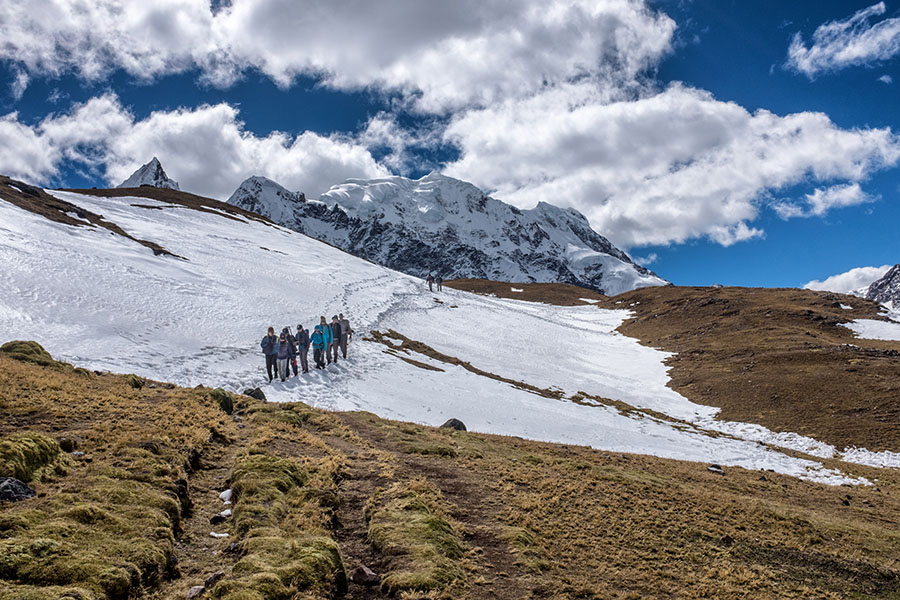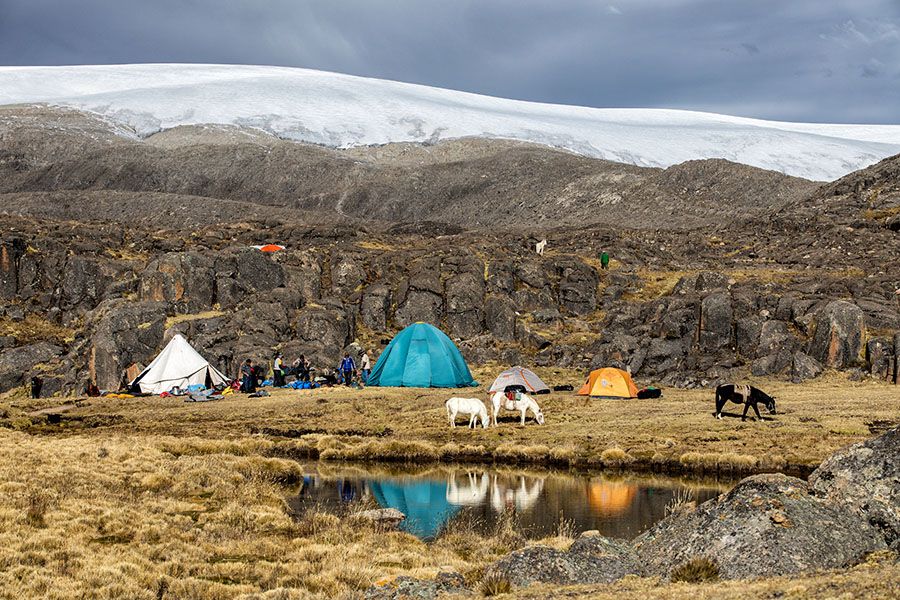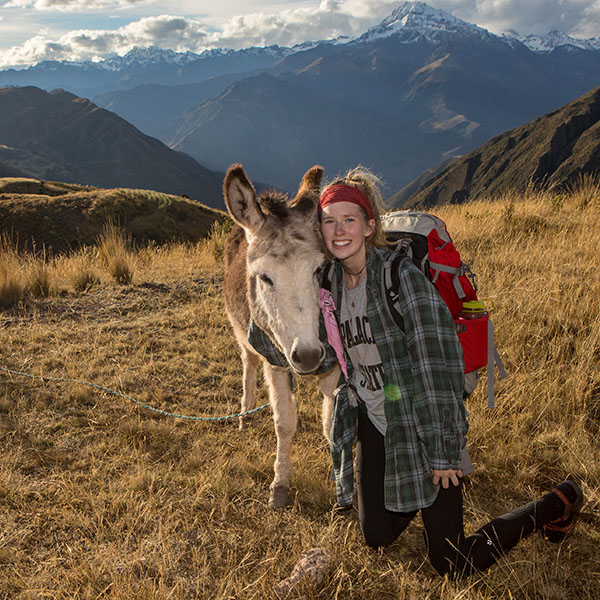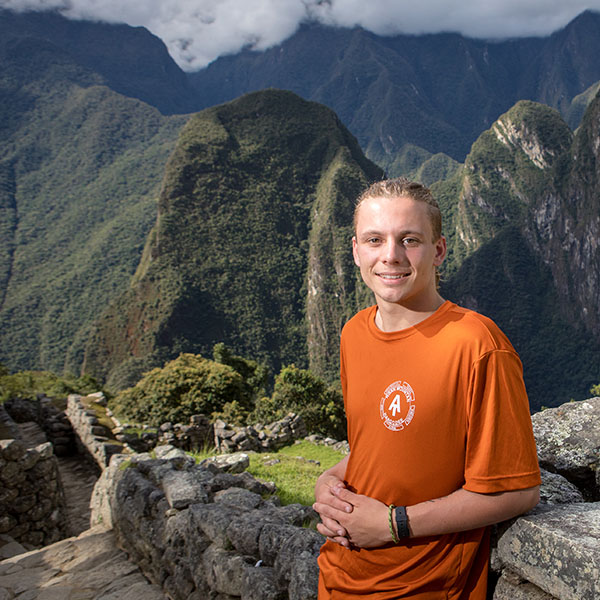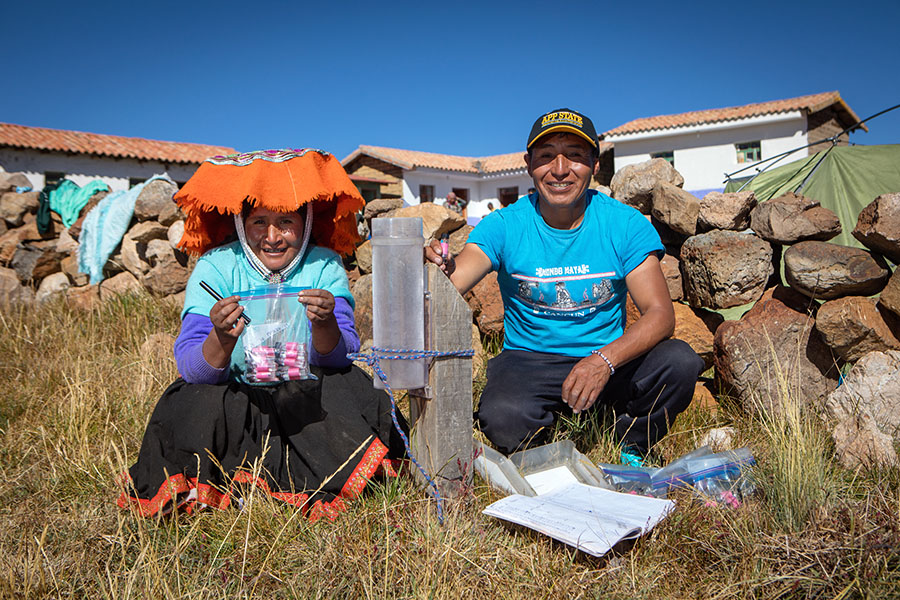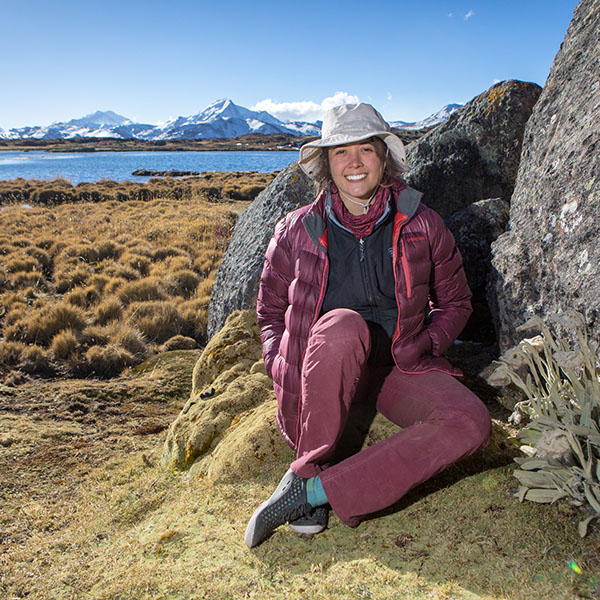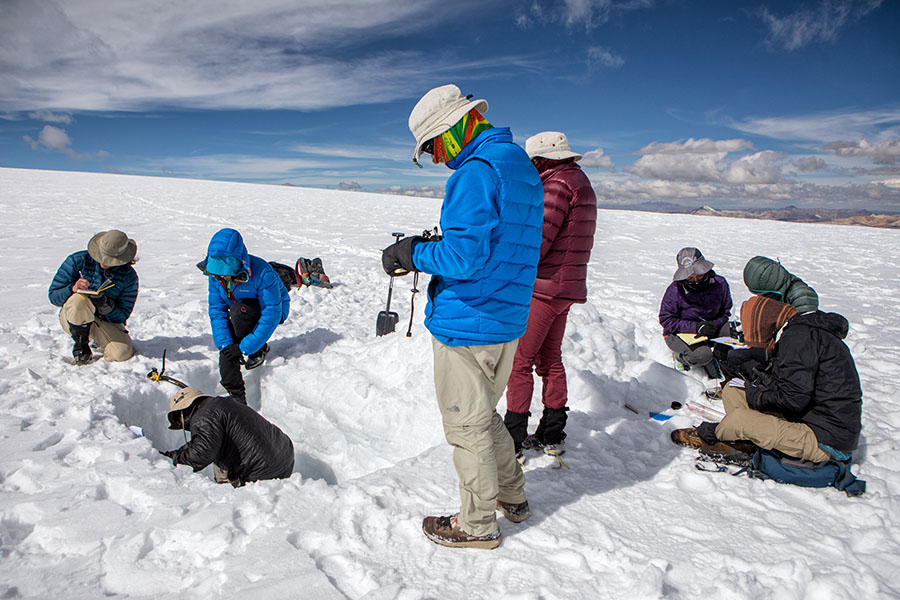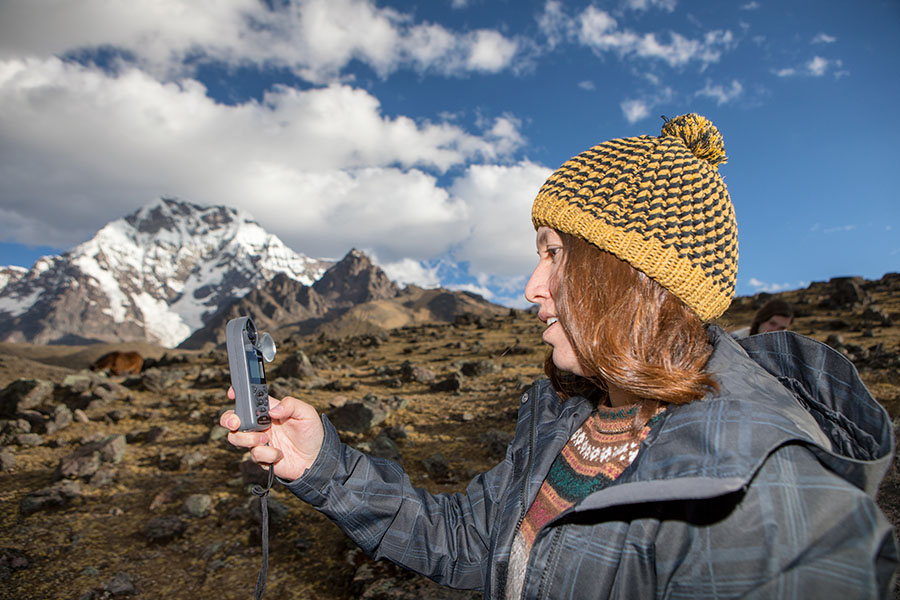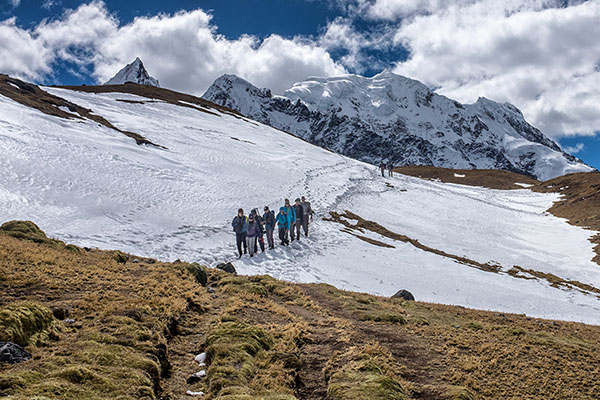BOONE, N.C. — Education abroad takes Appalachian State University students all over the world to experience art, different cultures and fresh perspectives. They visit international business centers, renowned art museums and developing nations. Occasionally, these expeditions take students somewhere else entirely — to the edge of their physical and mental endurance levels.
The summer 2018 study abroad in Peru was one such trip, providing students the opportunity to climb mountains and traverse glaciers, all while participating in critical climate research projects that may impact the world.
Dr. Baker Perry, graduate program director and professor in Appalachian’s Department of Geography and Planning, led 11 students from the heart of the Inca Empire to the top of the Quelccaya Ice Cap in Peru. They gazed upon Machu Picchu, one of the Seven Wonders of the World, slept in tents at subfreezing temperatures, dined on guinea pig, hiked to elevations over 18,000 feet and took scientific measurements to better understand the effects of climate change.
This was Perry’s 14th time taking students to the Andes Mountains, an Appalachian education abroad experience offered through the university’s Office of International Education and Development.
Perry, recognized as one of the top experts in his field, is one of a handful of researchers who have placed weather stations at high elevations worldwide to study the changes in climate and their impacts on populations.
The trip not only gave students a chance to participate in research, it also introduced them to the harsh and rigorous conditions that are often a part of climate science careers. Perry said, “The fieldwork in high mountain environments is physically challenging, with strenuous hiking, camping and gathering data at high elevations and adapting to the cold.”
Most of the learning took place in the field, Perry said, and undergraduates earned credits for two courses: Andean Mountain Geography and Climate and Tropical Glaciers.
The ascent
The trip began in Cusco, once the capital of the Inca Empire. At an elevation of about 11,500 feet, the city allowed the travelers to acclimate to the Andes and ease into the culture.
Mary Campbell Spencer, a sophomore geography-general major from Charlottesville, Virginia, said, “The trip was a progression in acclimating. We had a lot of resources in Cusco, but as we continued, access to everything from electricity to drinking water to showers and general hygiene went downhill.”
Strenuous hikes opened the trip, with an excursion to Machu Picchu, a 15th-century Incan city and archaeological wonder. The group climbed over 2,100 feet to the summit of Montaña (Mountain) Machu Picchu, navigating steep, narrow stairs and trails with sheer drop-offs along the mountain’s edge.
“Preparation is key in a trip like this,” Perry said. Months prior to the trip, he provided students with a detailed fitness workout schedule: hill sprints, runs and strength routines that included squats, lunges and pushups.
After all, the students would be hiking for eight straight days, crossing high mountain passes with steep ascents and descents.
Geography major Alex O’Neill from Cary, who has since graduated and started graduate school, said, “Dr. Perry did a good job of impressing upon us the climate would be cold and harsh.” Prior to the trip, O’Neill met with other participants to work out, running up and down the stairs at Kidd Brewer Stadium and hiking the steep and rigorous Profile Trail on Grandfather Mountain.
Academically, the students prepared with advance reading assignments on topics including climate and land management, sustainable tourism, environmental degradation in the Andes and climate research findings relative to the region. While traveling, O’Neill and other students took turns leading discussions during daily class time.
After a few days of touring, the group set up camp in Pucarumi, at an altitude of 13,500 feet. They pitched their tents in the yard of the Crispins, a host family that has been involved with Perry’s research projects for years as citizen scientists. Members of the Crispin family gather weather data to assist Perry in research to understand climate change in their region.
Perry’s group shared the campsite at the Crispins with another group of Appalachian students led by Dr. Jeremy Ferrell, director of Appalachian’s sustainable technology program and assistant professor in the university’s Department of Sustainable Technology and the Built Environment.
Tatiana Magee, a senior community and regional planning major from Rutherfordton, said interacting with the locals was her favorite part of the program led by Perry. “I’m able to speak Spanish, so I could communicate easily. I loved seeing their way of life, (and) what is normal to them compared to what is normal to me,” she said.
Magee said talking with some of the locals connected her more closely to problems stemming from climate change. “We had a guide (Don Severino Crispin Huanca) who was 69 years old, and he was telling us about his childhood, how a particular mountain used to be covered by snow and isn’t anymore,” she said.
Crispin’s eyewitness account impressed upon Magee and the other students how much the climate has changed in just a few decades, and how people’s lives are impacted when retreating glaciers threaten their source of water.
Perry’s graduate teaching assistant, Elizabeth Bailey of Charlotte, said, “The biggest challenge of any long-distance trek is the mental component of keeping a positive attitude at the point when your body hurts, but you have to keep hiking. Often what is tested even more than your muscles is your mental ability to adapt outside your comfort zone.”
Over the next few days, Perry’s group continued to work their way upward. The 10-mile trek across the Jampa Pass took the hikers up and down steep terrain, with a 2,500-foot gain in elevation over the duration of the hike, peaking at 16,700 feet.
“We hiked about seven hours that day,” Spencer said. “We were churning forwards, and I remember that’s when the joking stopped, and conversation stopped. We were feeling the burn of the mountains and being humbled by it.”
The day after crossing the Jampa Pass, the group continued to a campsite at the base of the Quelccaya Ice Cap, where the students performed weather-related field experiments and prepared for the summit hike the following day to an elevation of 18,500 feet.
The science
The Quelccaya Ice Cap is the largest glacier in the tropics, Perry said. “People in the Andes rely on glacier runoff for part of their water supply, particularly in the dry season. As the glaciers have begun to melt faster, the water supply increases initially, but then there is an adjustment that occurs, and there is less water,” he explained. “In some cases, glaciers have disappeared. Some watersheds have already peaked, and others have a few decades left.”
Perry continued: “We’ve been trying to improve scientific understanding of meteorological processes associated with precipitation, and on the basis of that, we can look at the snow pack on the glaciers and look back in time to have a richer understanding of what the climate was in the past. That will help us know what to expect in the future.”
Five years ago, the first allocation of a National Science Foundation (NSF) grant for the Integrated Climate Research and Education: Central Andes Precipitation Project (ICECAP) was used to install a comprehensive precipitation monitoring system on the Quelccaya Ice Cap. Similar equipment was installed on Chacaltaya Mountain in the Bolivian Andes. The equipment measures temperature, humidity, wind, precipitation type and snow depth, Perry said.
Each precipitation event creates a new layer in the ice on Quelccaya. While on the ice cap, the students dug a snow pit representing the latest year’s accumulation. They sampled each layer, then bagged the samples to take back to U.S. to analyze.
Dr. Anton Seimon, a research assistant professor in Appalachian’s Department of Geography and Planning who joined Perry’s group the day before their journey to the glacier’s base camp, explained the research process that occurred back in the lab.
“We obtain chemical measurements to get a profile of each layer of snow. By establishing a very tight relationship between the meteorology that produces the snowfall and the isotopic chemical signals that are preserved in the snowpack, we hope to better understand what those chemical signals mean when we look at ice cores across much longer time series, going back thousands of years,” he said.
“Rather than looking forward to the future of climate, we’re looking backward at how the climate has changed in the past,” Seimon said.
Climate history is “extremely important” in assessing how climate will change, he added. “This work has been very valuable to this part of the world. Just over the mountain summit, over there is the Amazon rainforest, a place of enormous global importance,” Seimon said.
“Bringing students to a place like this, to see the research as it is being done, is incredibly informative. I wouldn’t be surprised if some of these students go on to careers in global change studies, perhaps motivated by things they have seen on this trip.”
The impact
Perry said, “Over the past five years, this project has provided insight into how precipitation forms, where moisture comes from, when it falls and the height at which snow changes to rain. These are all critically important variables to understanding climate and how it is changing, how it influences glacier behavior and how it affects agriculture and water resources in the Andes.”
For many of the students, observing and participating in the process on Quelccaya was a landmark moment. O’Neill said, “I had spent months and months working with data from this place, imagining what it was like. Then, to actually be standing on top of the ice cap, the numbers came to life.”
O’Neill began Appalachian’s geography graduate program this semester. “Being able to assist in the field campaign in the Andes was a strong sell point for grad school,” he said. “It’s hard to turn down the potential to do that again.”
While the science atop Quelccaya was the highlight, O’Neill said he was also impressed by the impact of tourism on Machu Picchu.
“As a geography major, a lot of what I focus on is how humans interact with their environment. Machu Picchu is a good case study for that,” he said. “There is so much traffic from tourism that they’ve actually measured the foundation of the mountain sinking and sliding off. As a result, they’re doing a lot of work to promote the idea of sustainable tourism at Machu Picchu. I’ve read about this, and it has been really helpful to see that in action.”
Going to Peru helped Magee decide what she’d like to do with her future. “I got to see what it’s like to be in the field, and how advancing my education in geography will help me achieve my career goals,” she said. She is now applying for accelerated admission to attain a master’s degree in geography from Appalachian.
Perry said, “There are important lessons we can learn, for the United States — how water has been managed, how crops have been grown in extreme environments, how cultures have flourished in seemingly inhospitable conditions. I hope this experience provides students with a curiosity, a desire for lifelong learning about places and cultures other than our own.”
A Peru study abroad becomes a metaphor for the Appalachian Experience
What do you think?
Share your feedback on this story.
About the Department of Geography and Planning
The Department of Geography and Planning promotes the understanding of the spatial dimensions of human behavior within the physical and cultural systems of the earth, and the role of planning in achieving improvement in those systems. The department offers degrees in geography and in community and regional planning. Learn more at https://geo.appstate.edu.
About the College of Arts and Sciences
The College of Arts and Sciences (CAS) at Appalachian State University is home to 17 academic departments, two centers and one residential college. These units span the humanities and the social, mathematical and natural sciences. CAS aims to develop a distinctive identity built upon our university's strengths, traditions and locations. The college’s values lie not only in service to the university and local community, but through inspiring, training, educating and sustaining the development of its students as global citizens. More than 6,800 student majors are enrolled in the college. As the college is also largely responsible for implementing App State’s general education curriculum, it is heavily involved in the education of all students at the university, including those pursuing majors in other colleges. Learn more at https://cas.appstate.edu.
About Appalachian State University
As a premier public institution, Appalachian State University prepares students to lead purposeful lives. App State is one of 17 campuses in the University of North Carolina System, with a national reputation for innovative teaching and opening access to a high-quality, cost-effective education. The university enrolls more than 21,000 students, has a low student-to-faculty ratio and offers more than 150 undergraduate and 80 graduate majors at its Boone and Hickory campuses and through App State Online. Learn more at https://www.appstate.edu.

